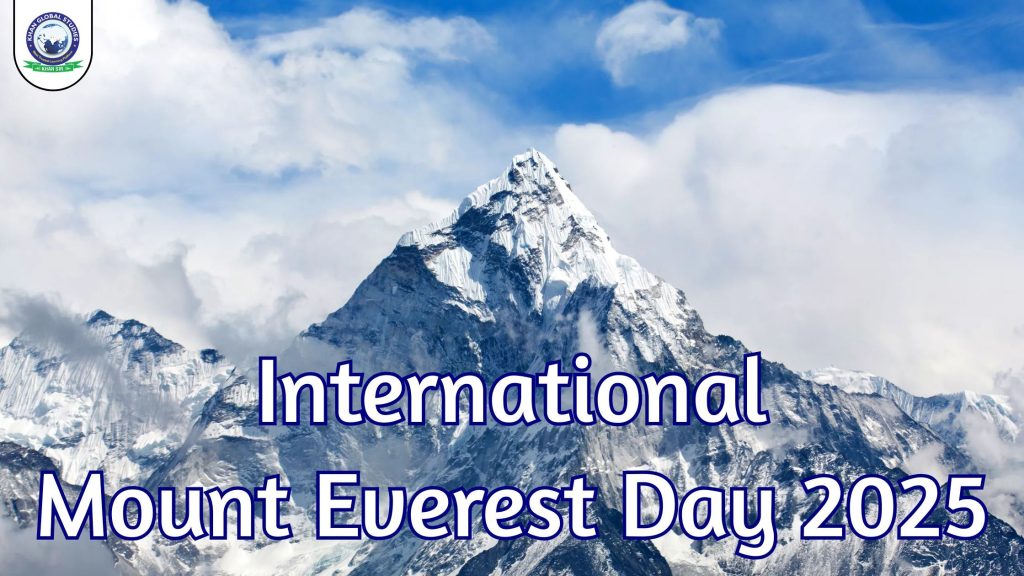Every year on May 29, International Everest Day is celebrated to honor an unforgettable achievement in the history of mountaineering. This day is a tribute to Nepal’s Tenzing Norgay and New Zealand’s Sir Edmund Hillary, who, in 1953, became the first people to successfully reach the summit of the world’s highest peak, Mount Everest. Their accomplishment became a symbol of human courage and determination, inspiring generations of mountaineers to follow in their footsteps.
History of International Everest Day:
Located on the border of Nepal and China (Tibet), Mount Everest is more than just a mountain—it stands as a symbol of human resolve and bravery. It is known by various names in different languages and cultures. In Nepali, it is called Sagarmatha, meaning “Head in the Great Blue Sky.” In Tibetan, it is known as Chomolungma, meaning “Mother of the World.” The English name “Everest” is derived from British Surveyor General Sir George Everest.
Early Attempts and Historic Success
Attempts to scale Everest began in the 1920s with British expeditions. Though many climbers came close, success finally came in 1953 during the ninth British expedition. At 11:30 AM on May 29, Tenzing Norgay of Nepal and Sir Edmund Hillary of New Zealand became the first to officially set foot on the summit.
Some historians speculate that British climbers George Mallory and Andrew Irvine may have reached the summit in 1924, but they went missing during their final ascent, and it remains a mystery whether they succeeded. Mallory’s body was discovered in 1999, but no conclusive evidence was found.
Hence, Norgay and Hillary are recognized as the first official summiteers of Mount Everest.
The Beginning of a Tradition
International Everest Day was officially established in 2008 after the passing of Edmund Hillary. The Government of Nepal declared May 29 as “Everest Day.” Since then, this day has not only honored their historic climb but also celebrated the limitless potential, patience, and spirit of exploration in humanity.
Mount Everest: The Ultimate Challenge
Mount Everest, at a height of 8,849 meters (29,032 feet), is the tallest mountain on Earth. It continues to attract adventurers from across the globe. Harsh weather, snowstorms, and oxygen deficiency make it a unique and grueling challenge—one that tests the extremes of mental and physical endurance.
Everest: A Symbol of Faith and Culture
Everest is not only a natural wonder but also a sacred place in Nepali and Sherpa culture. Sherpas call it Chomolungma—”Mother of the World”—and perform puja ceremonies before every ascent to seek blessings for a safe journey. Sherpas also play a crucial role in preserving the mountain’s environment by cleaning waste left by climbers to maintain its sanctity and beauty.
A Legacy of Inspiration
Since the historic ascent by Norgay and Hillary, thousands of climbers from around the world have attempted—and many have succeeded—in reaching the summit. Every year, Everest Day becomes a symbol of courage and confidence, reminding us that no goal is impossible with strong determination.
Climbing Everest: A Tough and Costly Endeavor
At nearly 8,850 meters above sea level, climbing Everest is a bold and expensive pursuit that comes with many challenges:
- Low oxygen levels: At the summit, air pressure is just one-third of that at sea level. Climbers rely on supplemental oxygen.
- Extreme weather: Harsh conditions can lead to frostbite, blizzards, and avalanches.
- Khumbu Icefall: Known for its deadly crevasses and unstable ice formations.
- Crowds and delays: In recent years, traffic jams near the summit have forced climbers to endure oxygen-deprived conditions for longer durations.
- Fatalities: Over 300 climbers have lost their lives on Everest. The 1996 blizzard claimed 8 lives, and avalanches in 2014 and 2015 led to several more deaths.
Celebrations and Events
On International Everest Day 2025, various events will be organized worldwide, including exhibitions, seminars, cultural performances, rallies, and adventure sports. In Nepal, this day is celebrated with great enthusiasm, with active participation from mountaineers, tourists, and local communities.
The Need to Protect Nature
While we celebrate this incredible human feat, it is also important to preserve Mount Everest’s fragile ecosystem. Increasing tourism and mountaineering have adverse effects on the environment. Thus, promoting sustainable tourism and conservation has become a priority.
Cost of Climbing and the Role of Guides
Climbing Everest is not cheap. Professional guides and expedition services can cost anywhere between $30,000 to $200,000. Most climbers attempt their ascent during a narrow window in April–May, when the weather is most favorable.
Conclusion
International Everest Day reminds us that there are no limits to human willpower and perseverance. The legendary feat of Tenzing Norgay and Sir Edmund Hillary is not just a milestone in mountaineering history, but also an everlasting source of inspiration for all who aim high in life. This day encourages us to dream, to struggle, and to achieve.





